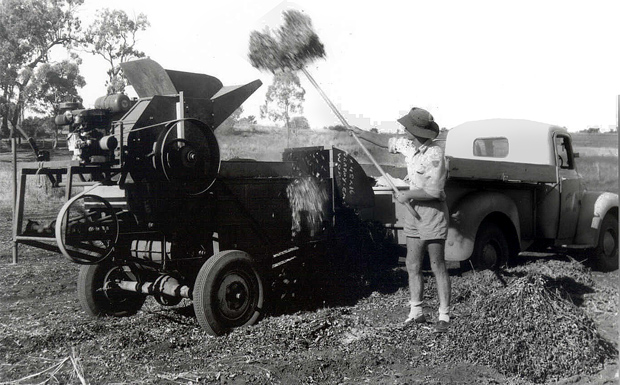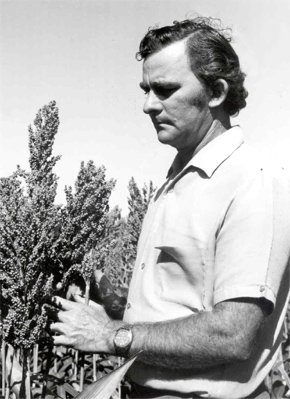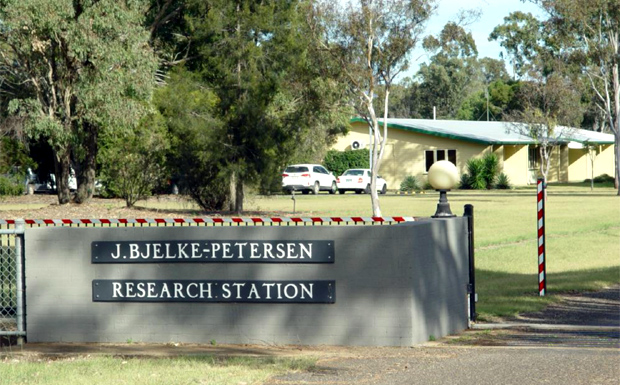

September 15, 2016
The Department of Agriculture and Fisheries’ J. Bjelke-Petersen Research Station will be holding an Open Day on October 6 to celebrate 100 years of Department Of Agriculture involvement in Kingaroy.
Over the years, the Department has altered its name at least three times – from the Department of Agriculture and Stock to the Department Of Primary Industries, and now to the Department of Agriculture and Fisheries – but it has maintained a constant presence in Kingaroy for 100 years, expanding from a single field officer in 1916 to a staff of 34 in 2016.
During this time it has played a major role in the development of the South Burnett’s peanut and navy bean industries, helping to develop new varieties better-suited to the region’s soils and climate.
Its researchers have also assisted the region’s graziers and foresters, and provided advice on the development of inland fisheries at Boondooma and the Bjelke-Petersen dams.
A remarkable achievement was the introduction of contour banks (see below) during the 1940s which put a halt to widespread erosion, despite initial scepticism from farmers.
This work has helped keep the South Burnett a productive agricultural area for the past 70 years.
On Thursday, October 6, the Research Station at 214 Kingaroy-Cooyar Road, opposite Kingaroy Airport, will open its gates from 9:00am to noon to the public.
Visitors will be able to take walking and bus tours of the facilities as well as inspect displays and look over a collection of historical memorabilia, much of it rarely seen.
Past staff have also been invited back for a barbecue lunch with present staff members, and group photos.
For catering purposes, though, past staff will need to RSVP to (07) 4160-0700 by September 19.

* * *
A Brief History Of DAS/DPI/DAF In Kingaroy
by Peter Want
The first Department of Agriculture and Stock officer in Kingaroy was S. K. Crowther, who was appointed as an Inspector under the Dairy Produce Acts on October 6, 1916.
Mr Crowther was paid £180 per annum plus a £60 “forage allowance”, and also served as an Inspector of Stock.
Within a few years, a separate Dairy Inspector was appointed, along with the first full-time Inspector of Stock.
They were joined by Arthur Grimley in 1920, who was appointed as Inspector-in-Charge of the South Burnett Tick Cleansing Area as well as Inspector of Stock, Brands and Slaughterhouses.
The Department’s “agricultural presence” in Kingaroy began to gather steam in 1938 when Arthur ‘Artie’ Kerr was transferred to Kingaroy as an Instructor in Agriculture.
In the 1930s, South Burnett farmers were becoming very concerned about soil erosion, and soon after Mr Kerr’s appointment, local farmers sought his help for soil conservation.
With the assistance of Frank Skinner, a soil conservationist based in Toowoomba, the men guided farmer Harry Royle to construct the first contour banks in the district in mid-April 1940.
At that time many considered contour banks a joke.
But other district farmers including Cec Hasemann, the Grayson brothers, Harold Larson, Roy Buttsworth, Len Hansen and Harry Bird soon followed, and by the end of WWII their pioneering work had stood the test of time.
This wartime interest in the South Burnett was sparked by the realisation that the area was suitable for producing the protein grains (navy beans and soybeans) that were used to feed Australian and American troops, and were in short supply.
After the war, Australia’s navy bean requirements still exceeded local supplies, and this created an opportunity to develop a local industry.
The standard variety then in use was not entirely suited for Queensland’s conditions, so Hubert Groszmann (Horticulture branch) and Artie Kerr (Agriculture branch) began a breeding program in the South Burnett, ultimately creating a navy bean variety they named Kerman.
In May 1945, Artie Kerr was promoted to Senior Adviser in Agriculture, and was joined by W.J. White, Adviser in Agriculture, in early 1946 and Maurie Finlay, Field Assistant, in late 1946.
By the late 1940s it was recognised that while much of the Department’s research work was carried out on local farms, it was essential to have some land where officers could control all aspects of their research work.
In the 1950s land was leased at Crawford, at the Kingaroy aerodrome, and near the Kingaroy sale yards.
And early in the 1960s, the late Mr Hill allowed DPI researchers free use of his land in Prince Street.
This land was later acquired by the Department, which erected a research glasshouse and other buildings there in 1965-66.
Finally, in response to demands from local primary producers to provide a base from which research could be conducted in the South and Central Burnett areas, a 53ha site at Taabinga was acquired in 1970.
Design of a research complex began in 1971, and the Works Department began construction in 1973.
Facilities included offices and laboratories for administration, research and advisory staff, mainly from Agriculture, Entomology, Plant Pathology, the Soil Conservation Branches and Veterinary Services.
Storage rooms and a toilet block were also included.
Staff from the Artie Kerr Centre and other sites moved into the new facilities in March 1975.
The complex was officially opened by Sir Colin Hannan, Governor of Queensland, on May 7, 1975, and named the J. Bjelke-Petersen Research Station.
Other guests at the official opening included Premier Joh Bjelke-Petersen, Primary Industries Minister Vic Sullivan and Primary Industries Director-General Dr J.M. Harvey.
An additional 56ha of land was bought in 1980 at Redvale to accommodate the peanut breeding program and provide a site for long-term soil studies.
In 2005, during Primary Industries Week, the Research Station celebrated its 30th anniversary with an Open Day which included 40 interactive displays, 25 year service awards, past staff catching up and the interment of a Time Capsule to be opened in 2025.
For the Department’s 90th anniversary in 2006, a Farmer Breakfast was held and a float was run in the Kingaroy Peanut Festival Parade highlighting past red soil conservation efforts, as well as more recent research in aerial remote sensing.
Currently the Department has more than 34 staff employed at the Research Station, with expertise in peanut plant breeding, farming systems, summer and winter grain pulse development, entomology, plant pathology, inland fisheries, forestry plantation products, biosecurity, financial counselling, and animal health and welfare.























